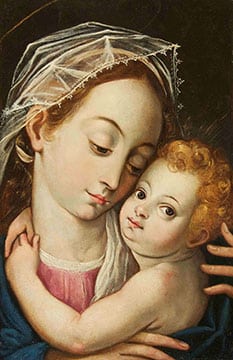University of Chicago Students Visit Art Institute’s “Doctrine and Devotion” Exhibit
“The trip was a delightful opportunity to see an exhibit that might not have otherwise been on my radar,” said one student. “The art was all exceptionally beautiful. And, of course, hearing Thomas [Levergood] intone the Salve Regina in the middle of the Art Institute only heightened the aesthetic experience.”
Lumen Christi’s University Program fosters a deeper engagement by students and faculty not only with the Catholic Church’s intellectual and spiritual traditions, but with its artistic and aesthetic traditions as well.
On October 5, executive director Thomas Levergood led a group of ten students to the Art Institute of Chicago for an evening visit. The trip was cosponsored by the University of Chicago’s Hildegard of Bingen Society, a non-sectarian student group that facilitates study of Christian thought, history, and culture.
The purpose of the trip was to enjoy one particular visiting exhibit at the Art Institute: “Doctrine and Devotion: Art of the Religious Orders of the Spanish Andes.” Presenting thirteen paintings by South American artists from the seventeenth through nineteenth centuries, “Doctrine and Devotion” introduces visitors to images promoted by several Catholic orders at work in the Spanish Andes—the Dominicans, Franciscans, Mercedarians, and Jesuits—and examines the politics of the distinct iconographies each group developed as it vied for devotees and prominence.
Students were encouraged to remain in that exhibit and to dwell at length upon the paintings. Then, in accord with a custom observed during Lumen Christi visits to the Art Institute, Levergood led the group in chanting the Salve Regina in front of a painting of the Virgin Mary. “It’s fitting that before leaving the exhibit, we say goodnight to our Mother,” he said before chanting the opening notes.
Trevor von Boeck, a philosophy major, was grateful for the highly concentrated purpose of the visit.
“I enjoyed having the opportunity to spend time focusing in close detail on a few paintings. In particular,” he said, “I was struck by the representations of the mendicant orders and the fervent devotion to Mary that sprung forth from most of the paintings.”
Afterward the group enjoyed dinner at the Art Institute’s famous rooftop terrace restaurant, Terzo Piano, before returning to Hyde Park.
“Doctrine and Devotion” is on loan to the Art Institute from the Carl and Marilynn Thoma Art Foundation, whose patrons are friends of Lumen Christi. According to its website, the Foundation “recognizes the power of the arts to challenge and shift perceptions, spark creativity and connect people across cultures.”
Learn more about “Doctrine and Devotion.”
The Thoma Art Foundation has loaned exhibits to the Art Institute in the past as well. From late 2014 to early last year, it cosponsored the exhibit “A Voyage to South America: Andean Art in the Spanish Empire”—the Art Institute’s first exhibition of Latin American art of the viceregal period (roughly 1521 to 1821)—which was hosted in the same rooms as “Doctrine and Devotion,” Galleries 212 and 212A. In 2015 Lumen Christi sent a group of students to admire that display.
Jack Sexton, a doctoral student in the John U. Nef Committee on Social Thought with interests in American political thought and the history of philosophy, was moved by the piety expressed in the images.
“As someone who was neither raised Catholic nor has much feeling for visual art, I found the exhibit surprisingly moving,” Sexton recounted. “The circumstances of the South American missions could not be further removed from those of people in ‘advanced’ countries today, and yet the piety expressed in these extraordinary works of art, simple but in no way naïve in the pejorative sense, still really strikes home.”
Daniel Ortiz, a fourth-year Fundamentals major, said of this year’s visit, “it was a delightful opportunity to see an exhibit that might not have otherwise been on my radar. The art was all exceptionally beautiful, but my favorite was the depiction of the Virgin Mary as La Divina Pastora (the Divine Shepherdess).”
“And, of course,” he added, “hearing Thomas intone the Salve Regina in the middle of the Art Institute only heightened the aesthetic experience.”
“Doctrine and Devotion” will be on display at the Exhibit through January 3, 2018.
Image: Bernardo Bitti (Italian, active in Peru, 1548–1610). Virgin and Child, about 1592–1605. Carl and Marilynn Thoma Collection.
